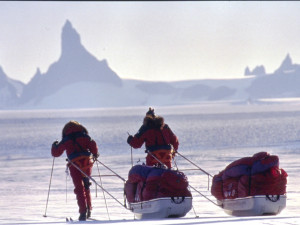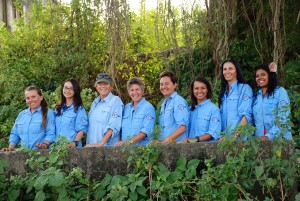Technology and social media with polar explorer Ann Bancroft
At the turn of the 20th century, the names of explorers were frequently brought up in households, restaurants and daily conversation across the globe. The Wright brothers made their first flight from Kitty Hawk, North Carolina. Freud released “The Interpretation of Dreams.” The Hubble telescope identified a new galaxy and marine biologists found life near deep ocean vents. All these discoveries were a part of popular culture.
Today, forays into the unknown are light years beyond the early 1900s. As researchers work toward finding a cure for cancer and diabetes, the classical art and science of discovery has changed immensely. Much of the Earth has already been explored, and characters like Shackleton and Ferdinand Magellan are unmatched. Yet, a small group of contemporaries are still finding life and death at the ends of the planet and corners of space. Ann Bancroft is one of these explorers as she breaks the boundaries of non-motorized travel and takes steps that prove doing something “like a girl” is anything but negative.
Polar exploration
While some kids dream of weddings and firetrucks, young Ann had much loftier plans. The now 61-year-old has conquered a list of impressive exploration feats, including being the first woman to reach both the North and South Poles.
Those interested in arctic travel have heard Ann’s name, yet her incredible accomplishments have received nothing like the worldwide recognition of Marco Polo or Leif Eriksson.
“We are a big country and it dilutes what and who we know – In other countries the old explorers are still known. There is more national pride. But there has been a shift in that with all the technology and our connectivity as well as the ability to now travel to exotic places that were once off limits because of finances and limited modes of travel. People have sort of lost the romance of it all,” Ann adds. “When I started on the public scene people’s imaginations were more keen.”
Born and raised in Minnesota, Ann is no stranger to the cold and has always been active. She began her career teaching physical education and coaching sports teams in St. Paul before moving to the Northern reaches of the state where conditions are optimal for training for freezing temperatures and blowing snow.
Her first arctic experience was participating in the Steger International Polar Expedition in 1986. The eight-member team, plus 50 dogs and sleds, traveled from Ellesmere Island to the North Pole with no outside support. This journey secured 31-year-old Ann’s position as the first woman to travel to the North Pole on foot and by sled. Six years later, in 1992, she led an all-female team who skied across Greenland, another first for women and the explorer.
Later that year, Ann and her expedition partner Liv Arnesen crossed Antarctica on foot and by ski. The duo traversed 1,700 miles in 94 days with only what they could carry. Their 250-pound supply sledges contained food, tents, warm gear and satellite phones that allowed the former schoolteachers to broadcast their journey to 3 million kids across 65 countries. The women recount the cold and wind, joys and injuries through journal entries and photographs in a book titled, “No Horizon Is So Far.”
“Being physical is the best way for me to communicate – to express myself. I am also drawn to places with few people – wide open places, cold or otherwise, draw me in,” Ann shared.

The evolution of adventure technology
The adventures of today’s explorers can be found on the glossy pages of National Geographic Magazine, or in fleeting scenes caught by documentary filmmakers equipped with drones and high-tech camera lenses. The general public encounters stunning feats, like Jimmy Chin, Conrad Anker and Renan Ozturk climbing Shark’s Fin on Mount Meru, through articles in travel publications or a brief clip on the news. But a dedicated group of fans live vicariously through these incredible individuals with the help of social media. Adrenaline junkies can get by-the-minute updates on their favorite expeditions by following along on Instagram, Twitter, Snapchat and Facebook.
“We use social media now. It’s critical if you’re trying to communicate,” Ann noted.
On expeditions, one of Ann’s major focuses besides safety is providing education. Because of this, she shared that it’s extremely important to understand your audience. She aims some content directly at kids, like reports from the ice during her Antarctica journey. Other social media is geared for adults, like grassroots movements that require funding and judicial attention.
Social media isn’t the only major transformation explorers have had to adapt to.
When Ann first began polar expeditions she used a sextant to navigate.
Think Pirates of the Caribbean but replace tropical air and Jonny Depp with glaciers and crevasses that could swallow you whole. Today, GPS and satellite phones make it possible for the explorer to do video conferences from just about anywhere in the world.
“Technology has changed hugely in my last 30 years of big expeditions,” Ann admitted. “It’s gotten more accessible and smaller. And then there is solar which has enhanced our world on trips. It has allowed our student audience to increase from the U.S. to the world, from thousands to millions.”
Ann believes there is terrific benefit and value in using new technology to share her journeys. The explorer looks up to Sylvia Earl and Jane Goodall, two women who “charted previously unexplored territories to get to their science.” Today, Ann and her expedition teams are following similar navigation by using social media and the Web to help school kids “visit” places they will likely never go themselves, and to spread the word about important causes.
Ann Bancroft Foundation
In 1997, Ann created a foundation in her name to help provide girls ages 5 through high school graduation with support and funds to follow their dreams.
“We want to be a hand extended to encourage a girl to live their full potential. When they do, our whole community thrives and is healthier,” Ann shared. She chose to focus the foundation around girls because they face many gender barriers. From earning lower wages than men to being expected to raise children and be homemakers, girls have less access to many opportunities.
The Ann Bancroft Foundation provides bi-annual “Dare to Dream” and “Let Me Play” grants that offer funding under $500 to art, cultural, educational, leadership, sport, dance and outdoor/wilderness experiences for girls. The money is available to Minnesotan organizations and residents and helps young ladies gain strength and belief in their abilities while building character and good values. Ann noted that the early years are tough on girls, and providing opportunities them to grow is very important.
“Words mean a lot and so do actions. Our girls say that an adult who listens to them, and takes them seriously, who is not their parents, carries great weight.” Ann added, “When we follow our hearts and do the things we most believe we should be doing, we can do anything. Don’t listen to the voices that doubt, that don’t know you. Keep stepping. Trying is never underrated.”

Future expeditions
Ann’s next major trek is planned for Oceania in 2017 with the Access Water Team. The trip is a part of a seven continent, multi-year journey bringing awareness and education about the importance of clean water. Ann will be joined by her polar expedition partner, Liv Arneson, as well as a group of other top women explorers from around the world. They plan to finish their Access Water journey in 2026 with a visit back to Antarctica.
When Ann is not planning or on an expedition, she spends time with her friends and family at home in the North country of Minnesota. She enjoys taking camping trips with loved ones or solo. Her favorite piece of gear is a knife, and she often uses binoculars and a journal while on treks big and small.
The educator and adventurer recommends reading the book “Tracks,” by Robyn Davidson. The story follows the young female narrator as she treks across the 1,700 miles of Australia with only camels and a dog at her side. There is a movie version but Ann prefers the book.
While Ann has participated in some major expeditions, she still holds smaller endeavors close to heart. “Adventure is in our own backyards. Attitude is everything,” she shared.
To follow along with Ann’s adventures at:
On the Web – www.yourexpedition.com
www.annbancroftfoundation.org
Instagram – @polarann59
@abfdreamers
Twitter – @polarann

